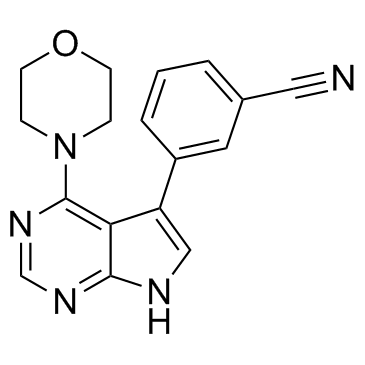1527473-33-1
| Name | 3-[4-(morpholin-4-yl)-7H-pyrrolo[2,3-d]pyrimidin-5-yl]benzonitrile |
|---|---|
| Synonyms |
pf06447475
PF-06447475 3-[4-(4-Morpholinyl)-7H-pyrrolo[2,3-d]pyrimidin-5-yl]benzonitrile Benzonitrile, 3-[4-(4-morpholinyl)-7H-pyrrolo[2,3-d]pyrimidin-5-yl]- |
| Description | PF-06447475 is a highly potent, selective and brain penetrant LRRK2 inhibitor with an IC50 of 3 nM. |
|---|---|
| Related Catalog | |
| Target |
IC50: 3 nM (LRRK2)[1]. |
| In Vitro | PF-06447475 inhibits LRRK2 enzyme and LRRK2 in the whole cell assay with IC50s of 3 and 25 nM, respectively[1]. Cells incubated with PF-06447475 alone (0.5, 1, 3 μM) or in the presence of ROT significantly reduces (S935)-LRRK2 kinase phosphorylation to control. PF-06447475 significantly preserves the nucleus morphology and ΔΨm of NLCs exposed to ROT compared to untreated and control. PF-475 significantly diminishes ROT-induced ROS generation to a similar extent to cells exposed to PF-475 alone[2]. |
| In Vivo | In G2019S+ rats treated with PF-06447475, a significant reduction in microgliosis to levels found in wild-type rats could be observed. The proinflammatory marker MHC-II expressed on myeloid cells but not neurons also appears to be less abundant in confocal sections in G2019S+ rats treated with PF-06447475. PF-06447475 treatment in G2019S+ rats significantly lowers the number of CD68 cells recruited to the SNpc. PF-06447475 successfully blocks the enhanced neuroinflammation associated with G2019S-LRRK2 expression. Treatment of G2019S+ rats with PF-06447475 preserves TH expression in the dorsal striatum, consistent with drug attenuating neurodegeneration in the SNpc[3]. PF-06447475 is well tolerated in rats[1]. |
| Animal Admin | Rats: PF-06447475 are administered to the desired amount in a suspension solution consisting of 10% propylene glycol, 20% PEG-400, and 70% 0.5% methylcellulose. To determine the potency of PF-06447475 in blocking brain LRRK2 kinase activity, wild-type Sprague-Dawley rats are treated at 3 and 30 mg/kg PF-06447475 (p.o. b.i.d.) for 14 days, and total and phospho-LRRK2 are subsequently measured from brain tissue lysates[3]. |
| References |
| Density | 1.4±0.1 g/cm3 |
|---|---|
| Molecular Formula | C17H15N5O |
| Molecular Weight | 305.334 |
| Exact Mass | 305.127655 |
| PSA | 77.83000 |
| LogP | 2.00 |
| Appearance | offwhite solid |
| Index of Refraction | 1.711 |
| Storage condition | -20℃ |
| Symbol |

GHS06 |
|---|---|
| Signal Word | Danger |
| Hazard Statements | H301 |
| Precautionary Statements | P301 + P310 |
| RIDADR | UN 2811 6.1 / PGIII |
